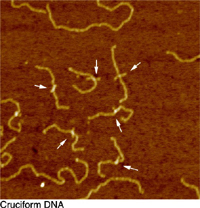
This microscopic image of DNA containing the chromosome 11 palindrome shows cruciform configurations (indicated by arrows), where potentially unstable sections of DNA protrude from the main strands. As the human genome gradually yields up its secrets, scientists are finding some genetic events, such as rearrangements in chromosomes, are less random than they had previously thought. Originating as structural weaknesses in unstable stretches of DNA, abnormal chromosomes may, rarely, result in a disabling genetic disease one or two generations later.
A report in the Feb. 17 issue of Science by genetics researchers at The Children's Hospital of Philadelphia and the University of Pennsylvania analyzes genetic predisposition to the translocation t(11;22), a swapping of genetic material between chromosomes 11 and 22. They found an unexpectedly high frequency of new translocations in the DNA of sperm samples from healthy individuals. (For technical reasons, egg cells cannot be tested for translocations.)
By and large, these translocations are not cause for alarm, because those men and their offspring are highly unlikely to be affected. Approximately one sperm in 100,000 has the rearrangement, so the chance of an affected sperm fertilizing an egg is exceedingly low. However, when that does occur, the child has a constitutional t(11;22) translocation--all of their cells carry the rearrangement. That child, in turn, while otherwise healthy, often has fertility problems as an adult. Further, if this adult does become a parent, his or her offspring may have an abnormal chromosomal composition and suffer a disabling multisystem disease.
The disorder, called supernumerary der(22) t(11;22) or Emanuel syndrome, results from the havoc caused by an extra chromosome composed of parts of chromosome 11 and chromosome 22. Like Down syndrome, it is a trisomy, a disease caused by an extra chromosome. Patients with the condition usually have mental deficiency, growth retardation, a heart defect, cleft or abnormal palate, and other symptoms.
Although the heart defects were often lethal in the past, advances in heart surgery are allowing children with Emanuel syndrome to survive longer. Parents with an affected child who want to have another child can now have prenatal testing done during a subsequent pregnancy.
The disease is rare; hundreds of cases are known worldwide. Many of those children and their families have been studied by Beverly S. Emanuel, Ph.D., chief of Human Genetics and Molecular Biology at The Children's Hospital of Philadelphia, and a co-author of the study. At the request of a parent support group, the syndrome was recently named after Dr. Emanuel, who first described the disease in 1980 with her colleague Elaine Zackai, M.D., also of Children's Hospital.
"We are learning a lot more about how chromosomes behave, or misbehave, since the completion of the Human Genome Project," said Dr. Emanuel, who played a major role in mapping chromosome 22 for that program. "We already knew, of course, that every time someone makes gametes, that is, sperm or egg cells, there is a possibility of introducing DNA changes. In this study, we asked if some people make those changes at a higher frequency, and found that this appears to be the case."
The researchers found that at the site where the translocation would occur, 87 percent of 394 normal chromosome 11 samples examined had repetitive stretches enriched in the DNA bases adenine and thymine, 450 bases long, in an unstable configuration called a palindrome. The other 13 percent of the chromosomes had shorter palindromic adenine- and thymine-rich sequences. Surprising was the finding that newly arising t(11:22) translocations occurred with a frequency of approximately one in 100,000 sperm cells from healthy men with the longer palindromic sequences. In contrast, men with a shorter palindromic sequence had a lower frequency of translocations.
"Palindromes are unstable sequences of DNA, and are prone to protrude from the DNA double helix in fragile structures called hairpins and cruciforms," said Hiroki Kurahashi, M.D., Ph.D., corresponding author of the paper. "The hairpins and cruciforms are weak points where the DNA can break and rearrange with DNA from other chromosomes."
Chromosome 22 also has palindromic hairpins and cruciform structures, where breaks occur and DNA swaps places with DNA from chromosome 11. Unlike more random, rarer chromosome translocations, the rearrangement between chromosomes 11 and 22 tends to recur, which led the researchers to investigate their DNA breakpoints in detail.
"Disorders based on peculiarities of chromosome architecture can be classified as genomic disorders," said Dr. Emanuel. Unlike single-gene diseases such as cystic fibrosis or hemophilia that result from mutations in one gene, genomic diseases originate in the broader structure of the genome--the full complement of DNA sequences in sets of chromosomes.
Recent research by Drs. Emanuel, Kurahashi and colleagues have detected other palindromic repetitive DNA sequences at the breakpoints of other translocations, suggesting that these unstable structures may play a broader role in chromosome abnormalities beyond the t(11;22) rearrangement.
Source : Children's Hospital of Philadelphia
 Print Article
Print Article Mail to a Friend
Mail to a Friend
